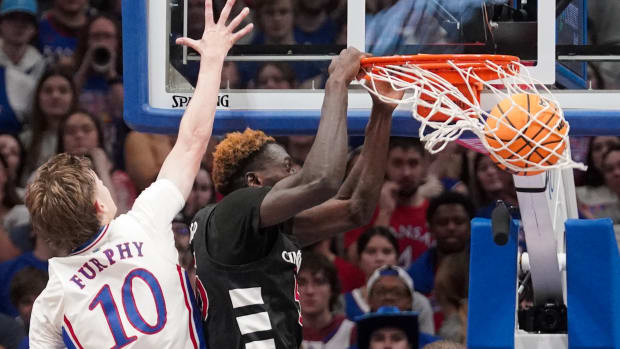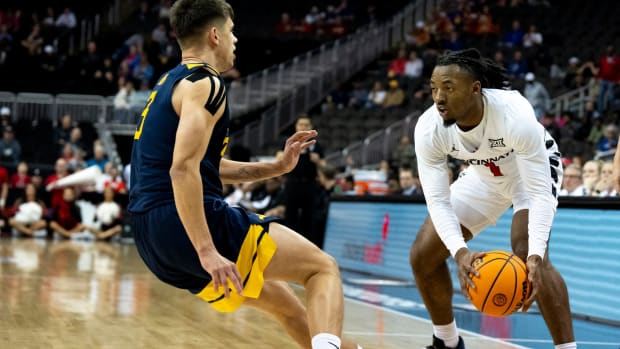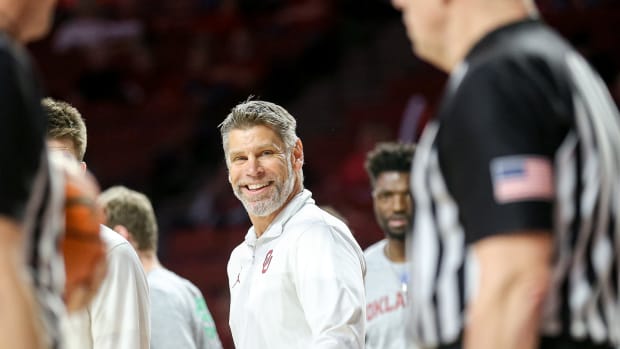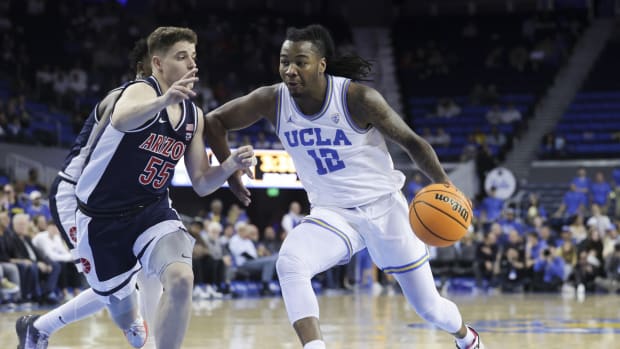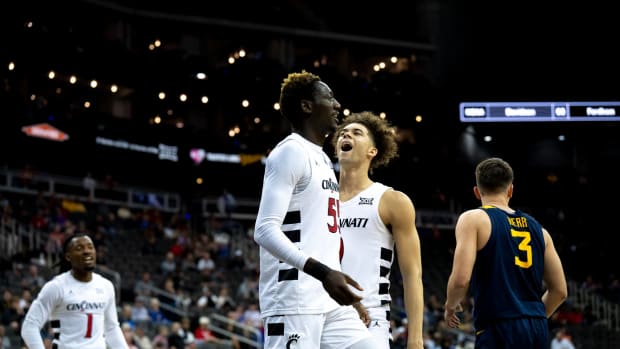Out of the rubble: How Northwestern finally broke through to claim its first NCAA tournament bid
This story originally appeared in the March 20, 2016 issue of Sports Illustrated. Subscribe to the magazine here.
They razed NCAA tournament history with a half-ton steel ball. Unceremoniously, too: Northwestern just needed its University Gymnasium out of the way. On April 2, 1940, students making their way to morning classes on the Evanston, Ill., campus—a narrow strip of land along the shore of Lake Michigan, just north of Chicago—gaped from behind a guardrail as a crane swung a wrecking ball into the east-facing stone wall of the basketball venue, until it cracked and crumbled.
One year and six days earlier, the gym hosted Oregon’s win over Ohio State for the championship of the first NCAA tournament—an event to which Northwestern was not invited. The 5,600-seat arena was widely (but unofficially) called Patten Gym, after James A. Patten, a wheat-market manipulator who’d paid for its construction in 1909. It was then regarded as the premier sporting facility in the Midwest: a Prairie School–influenced architectural gem with a high, arched roof that evoked the grandness of classic railway stations; extended panels of skylights; and hanging lanterns for night games, with purple-glass N’s cut into their sides. One can only imagine what kind of basketball tradition a Big Ten school might have been able to establish with such a bucket-list venue—one that predated Penn’s Palestra (’27), Butler’s Hinkle Fieldhouse (’28) and Duke’s Cameron Indoor Stadium (’40), and could be called the birthplace of the national title game.
Region-by-region breakdowns of the 2017 NCAA tournament
And imagine is all one can do. Because in 1939, railway-equipment baron Walter P. Murphy donated $6.7 million—the equivalent of $117.7 million today—to Northwestern for the building of a massive engineering school. The only way to make room for the Technological Institute was to demolish Patten Gym, a decision that ultimately forced the basketball team to play at Evanston Township High for more than a decade. The financial might of engineering had overpowered athletics—words that no one would ever get to write about major college sports in 2017.
“I guess that’s Northwestern for you,” Wildcats sophomore forward Vic Law says after being apprised of the university’s original sin against hoops history. It is late February, and Law stands on the court in the home Northwestern built for basketball in 1952; when it opened it was called McGaw Memorial Hall, and now it’s Welsh-Ryan Arena. The rafters above him are free of fabric, save for an American flag. There is no banner to commemorate ’39, nor any to note appearances in the NCAA tournament, because the defining aspect of the program is that, until Sunday, Northwestern had been the only major-conference school to have never received a bid to the dance. The 78 years of exclusion are referred to as either a drought or, for the supernaturally inclined, a curse.
The only remnants of the old Patten Gym on campus are its doors and two bronze statues—Greco-Roman depictions of an athlete and a scholar—that now guard the entrance to the new Patten Gym, an aesthetically inferior successor that went up in 1940 and was too small to host crowds for basketball games. Students now play pickup hoops there, and it’s where Law was on Selection Sunday last year, going against teammates Dererk Pardon and Jordan Ash in rotating games of one-on-one while they monitored a live stream of the NIT selection show on Law’s phone. They had accepted missing the NCAA field, but their 20–12 record didn’t pass NIT muster, either. Feeling pain and rejection in March—even from the NIT, which the Wildcats have reached just seven times—is a very Northwestern thing. “The conversation that night,” Law says, “was that if this team wants to get anywhere, people like us have to dedicate ourselves to finally making this place good.” Vowing to end the drought-slash-curse is also a very Northwestern thing; its basketball history is littered with such promises.
• Play the Fox/SI Bracket Challenge: Get a perfect bracket and win Cousin Sal's house
Actually ending it in 2017—and doing so on a full-court, Hail Mary inbounds pass from senior forward Nate Taphorn to Pardon for a buzzer-beating, game-winning layup against Michigan on March 1 at Welsh-Ryan—was, as alum and NBC’s Late Night host Seth Meyers tweeted, “the least Northwestern thing ever.” The Wildcats had entered that game on a familiar late-season trajectory. They had lost five of seven, dropped to 9–6 in the Big Ten, and had just two chances left to clinch an above-.500 record in conference play, which would virtually assure an NCAA bid. The scene after Pardon’s shot banked in—the player pileup near midcourt; students storming the floor; fourth-year coach Chris Collins running around like (in his words) “Jimmy V back in ’83,” looking for someone to hug—was pure joy fueled by relief. The Wildcats did not have to agonize through Selection Sunday 2017, when they were announced as the No. 8 seed in the West region. Seventy-seven years after the program was hit with a wrecking ball, it found its way out of the rubble.
***
It was futile.It was pretty bad. It had its moments but was by-and-large mediocre. It could have been The One, but unfortunate stuff happened. Before 2016–17, one of those four phrases described every Northwestern basketball season in the NCAA tournament era. What backup center Dan Kreft says about his mid-1990s teams—“You have to look back and laugh about a lot of it, because otherwise you’ll cry”—applies to many teams across the decades.
Did you know that Northwestern briefly had a Hall of Fame coach, Tex Winter, who, after an upset of Kentucky in 1975–76, proclaimed, “In a couple of years, this could be a national power”? In a couple of years, Winter quit with a record of 44–87, having told the athletic director in his final months, “I’ve won everywhere I’ve been, and I’m respected by my peers. If I stay much longer, I’m going to lose that respect.”
Did you know that in 1990, Northwestern had a Final Four–caliber guard? The asterisk is that he transferred to Kansas and started for the Jayhawks in the ’93 national semis. Rex Walters had averaged 17.6 points for the Wildcats as a sophomore in ’89–90, but he was ultracompetitive, and back-to-back 9–19 finishes gnawed at him. Once he was immersed in Kansas’s rich hoops culture, Walters says elements of his Northwestern experience seemed ridiculous: “Like the time, in the spring of my freshman year, when we lost a three-on-three tournament”—on the asphalt courts outside the north-campus dorms—“to a team of football players, and no one acted like it was a big deal.” Or the fact that on the locker room whiteboard, he says, “a few players literally kept a countdown to the final day of practice,” writing and erasing the number each day to hide it from the coaches. “That just wasn’t who I was,” Walters says. “I would cry at the ends of seasons at Kansas.”
Five takeaways from the NCAA tournament bracket reveal
Northwestern made national news for strange and dark reasons throughout the 1990s. On Feb. 7, 1994, first-year coach Ricky Byrdsong, driven to near madness by an 0–8 start to Big Ten play, chose to leave the bench and wander the crowd during a loss at Minnesota. In ’98, two players—Kenneth Lee and Dewey Williams—pleaded guilty on charges of sports bribery after conspiring with a bookmaker to shave points on three games during the ’94–95 season; a third player, Matt Purdy, was named as an unindicted co-conspirator. And in ’99, two years after Byrdsong was fired, he was shot and killed by a white supremacist in nearby Skokie, Ill.
The program made digital history in that same decade when Kreft began keeping what newspapers later called an “Internet diary” of life as a Wildcat. “I was a pioneer, of sorts,” says Kreft, the first known Division I athlete to write what would come to be known as a blog. In it, he chronicled events such as a players-only excursion to Tijuana during a road trip to San Diego State. Kreft still finds amusement in Byrdsong’s affinity for ordering motivational T-shirts, such as one that said 5–22 on the front—the team’s record in 1994–95—and NEVER AGAIN on the back. (In a Northwestern way, it worked, as the team went 7–20 the next season.) “But my all-time favorite shirt,” Kreft says, “was BRIAN'S MILE.”
As Kreft tells it, during a timed, preseason conditioning run through Evanston in 1994, forward Brian Chamberlain suffered a severe ankle sprain, and his determination to limp the final mile was such an inspiration to Byrdsong that he ordered BRIAN'S MILE shirts to remind the team about perseverance. What no one could tell the coaches about this supposed inspiration, Kreft says, is that Chamberlain’s injury occurred while trying to shortcut the 2.2-mile course by running through a yard, then landing awkwardly after jumping over a hedge.
Many Wildcats did not persevere through all the losing. Northwestern was so plagued by transfers—it lost more than 20 players in the 1990s, and at least 10 more in the 2000s—that an unofficial Wall of Shame was established in a hidden spot in its film room. A list of defectors, written in black marker, could be found by removing a ceiling tile above the television. By the time Northwestern’s best player of the 1990s, 6' 11" center Evan Eschmeyer, reached his peak, in his double-redshirt senior year of ’98–99, he was playing for Byrdsong’s successor, Kevin O’Neill, and starting alongside three freshmen. That team started 6–4 in the Big Ten, only to lose its final six conference games and miss the NCAAs. Eschmeyer remains the program’s most recognizable alum—“I guess I’m the one guy they can point to and say, ‘See, you can make it to the NBA out of Northwestern,’ ” he says—but NBA locker room discussions in March always resulted in his being mocked about his alma mater. “It would tick me off,” he says. “You want to be in that [NCAA tournament] club, right?”
After O’Neill—a notoriously difficult personality who drove eight players to quit or transfer over his three seasons—bailed on the team to take an assistant coaching job with the Knicks in September 2000, Northwestern replaced him with Princeton’s Bill Carmody. He became the most successful coach in school history . . . by taking the Wildcats to four straight NITs, from ’09 to ’12.
NCAA tournament first-round games: Schedule, game time, TV information
Carmody was a passive recruiter—he was absent when future Wooden Award winner Frank Kaminsky visited in 2010—but his great find was John Shurna, a baby-faced 6' 9" assassin from Glen Ellyn, Ill., with an unorthodox shot who became Northwestern’s all-time leading scorer. Shurna, who avidly follows the Wildcats while playing in Europe, insists that his December 2010 ankle injury (after which NU squandered its chance for an NCAA bid) was not part of a curse. Still, it was bittersweet for Wildcats fans to see him in a January 2016 New York Times story, serving as the human talisman (due to a caveman-grade beard he’d refused to shave) of a 28-game win streak by his Spanish club team, Valencia.
Asked if the beard was something he regrets not trying at Northwestern, Shurna says, “I don’t think I was even capable of growing facial hair then.” Alas.
***
At the end of Chris Collins’s first day on campus as coach—March 25, 2013—he and his wife, Kim, and their two young children wandered into an empty Welsh-Ryan Arena. It was around 9:30, and the gym was dark and quiet. “Those are the best times,” says Collins, 42, who liked to walk through a darkened Cameron Indoor Stadium when he was a Duke guard and assistant coach, “because that’s when you can dream.”
On that night he envisioned Welsh-Ryan being loud and packed, and his reference point was, understandably, not some date in Northwestern history. It was the final game of his own high school career, a sold-out state supersectional that his Glenbrook North team lost in triple overtime on that very floor. “The atmosphere was electric,” he says. “It was the coolest place I’d ever played in. That’s what I dreamed of this becoming for us.”
As a McDonald’s All-American just 10 miles from Northwestern’s campus, Collins had attended games at the invitation of then coach Bill Foster and had been hosted on unofficial visits by Eschmeyer. But Collins had scholarship offers from powerhouses. “There was just ... so much losing at Northwestern then,” he says, “that it never became an option for me in recruiting.”
Illinois' swift firing of John Groce a strong start to new era
Three decades later Collins was in the position of trying to sell recruits on a program that had continued to do so much losing. On his second day at Northwestern, he went to an open gym at St. Rita High on Chicago’s Southwest Side to see Law, who would become the first top 75 prospect since Eschmeyer to play for the Wildcats. Collins also began pursuing Bryant McIntosh, an underrated, three-star point guard at Greensburg (Ind.) High, whose game reminded him of former Duke star Jon Scheyer. When McIntosh made his recruiting visit that summer, Collins pitched Northwestern’s NCAA tournament drought as an opportunity—to be part of the first team to do something worthy of hanging in Welsh-Ryan. “You could leave your mark,” McIntosh recalls Collins saying. “People will always remember who did it first.”
McIntosh, Law and 6' 5" shooting guard Scottie Lindsey were part of Collins’s first full recruiting class, arriving in 2014. The Wildcats went 15–17 and 20–12 in that group’s first two seasons, and they were projected by SI to finish at .500 in the Big Ten in ’16–17. But when they gathered at Evanston’s Firehouse Grill for their traditional preseason dinner on Sept. 15, Collins set a more ambitious tone.
“This could be a special year,” he told them. “We finally have enough talent to really compete. We have enough guys who are skilled, and we have all the potential in the world. It’s all going to come down to our toughness.”
By the end of January the Wildcats had built a résumé—with nonconference wins over Dayton and Wake Forest, and a run of six straight Big Ten victories—that made it feasible to believe that this was the year. Several events, though, made it reasonable to worry that Northwestern was still cursed. Pardon, a 6' 8" sophomore center, suffered a broken right (nonshooting) hand. Lindsey was diagnosed with mononucleosis on Jan. 30 and couldn’t practice, train or even touch a basketball for three weeks. The Wildcats lost four of their next six, trended back toward the bubble in bracket projections and felt the enormous pressure of their drought-breaking quest. Two days after a Feb. 21 loss at Illinois, Collins urged his team to think back to the preseason, asking them, “If I had told you that on Feb. 23, you’re going to be 9–6 in the Big Ten and you’re going to be 20–8 on the season, how happy would you be?” McIntosh responded, “Ecstatic.”
“What would you want to do with it, then?” Collins asked. “Would you play with a lot of passion and excitement, or would you want to get the season over with, like a lot of other teams here in the past have?”
They vowed to do the former—and then went to Indiana two days later, surrendered a seven-point lead in the final two minutes and lost. Four days later in Evanston, the Wildcats blew a late lead against Michigan and called a timeout with 1.7 seconds left. With the score tied 65–65, they had possession underneath the Wolverines’ basket. The assistant coach who drew up the final play on the spot—with Pardon setting two screens and then slipping toward the rim, 92 feet from Taphorn—was Brian James, Collins’s high school coach for that seminal loss at Welsh-Ryan in 1992. What unfolded—Taphorn’s perfect overhand heave, Pardon’s catch, the banked shot as the backboard light went red—trumped anything Collins had dreamed about. It was the biggest win in Northwestern history.
Throwing in the chair: The increasingly bizarre and sad legacy of Bob Knight and Indiana
While the Wildcats are making their debut in the NCAA tournament, Welsh-Ryan will be undergoing a transformation. Breaking from its tradition of demolishing buildings with historic significance, Northwestern is putting more than $110 million into upgrading and reconfiguring the awkwardly laid-out arena, as well as building a much-needed practice facility that will open in 2018. If you walk the campus now, there is nothing marking the site of old Patten. But enter the Technological Institute that sits atop its grave and wander its labyrinthine hallways, past classrooms, offices and laboratory doors. In a second-floor hall that might have been above the court of that first championship game, you’ll discover something comforting.
One of the Institute’s professors, Sir Fraser Stoddart, won the 2016 Nobel Prize in chemistry for his work on molecular machines, which have aided in the treatment of cancer and other diseases. And you’ll know this because to commemorate Sir Fraser’s breakthrough, Northwestern did an un-Northwestern thing: It hung a banner.




